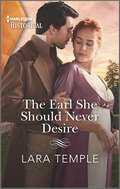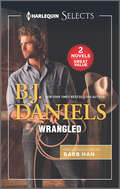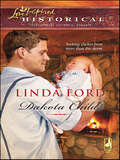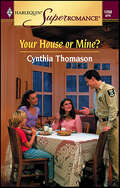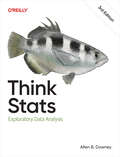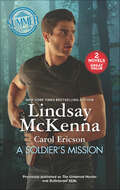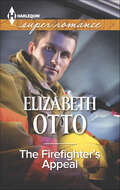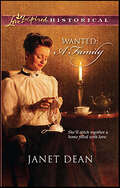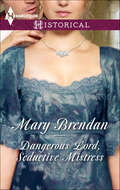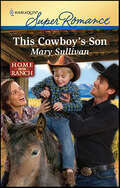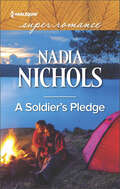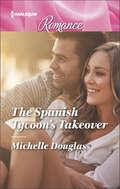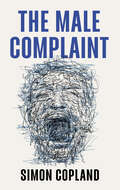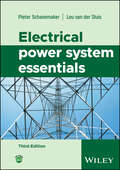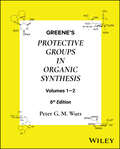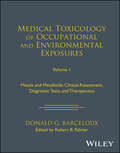- Table View
- List View
The Earl She Should Never Desire
by Lara TempleLara Temple offers you a taste of the forbidden in this sexy Regency romance.This very handsome earl…Is the one man she cannot fall for…War widow Lily Walsh has left her aristocratic family behind, but she can&’t deny her younger sister&’s request to come to London to meet her fiancé. Though not a love match, Lord Sherbourne is kind, amusing and ideal for her sister on paper. But as Lily gets to know him, she&’s finding him alarmingly attractive! And the forbidden look in the earl&’s eye shows the feeling is mutual…From Harlequin Historical: Your romantic escape to the past.
Her Amish Protectors
by Janice Kay JohnsonShe had wanted a simpler life in Amish country... The caring community in her new Missouri small town was a healing salve for Nadia Markovic's wounded spirit...until someone broke into her apartment above her Amish quilt shop and robbed her while she was sleeping. The thief made off with all the funds they'd just raised through the sale of her neighbours' handmade quilts. And police chief Ben Slater can't rule her out as the prime suspect. Only her Amish friends are willing to give her the benefit of the doubt. People are angry enough to even target her with violence... But while Ben might not trust her, he's committed to protecting her, confusing her feelings for this man who's pulling her apart!
Wrangled
by B.J. DanielsCan they find the truth…before it&’s too late?Wrangled by New York Times Bestselling Author B.J. DanielsDakota Lansing has always kept her distance from Zach Chisholm, the cowboy with a bad reputation. But with both their lives in jeopardy, Zach is her only hope of staying alive. Targeted by unknown assailants, Zach discovers his mysterious connection to Dakota is much bigger than either suspected. With time running out, should he let her rope him in and go along for the ride?Previously publishedFREE BONUS STORY INCLUDED IN THIS VOLUME!Delivering Justice by USA TODAY Bestselling Author Barb HanWhen Tyler O'Brien finds a woman lying helpless after an ATV accident on his Texas ranch, nothing adds up. But aiding the amnesiac only compounds his doubts. Learning that &“Red&” is searching for her twin sister who may have come to harm, Tyler promises to help. Soon they're pulled into a complicated mystery, and Tyler will have to draw on every ounce of strength to keep this stranger safe…Previously published
Dakota Child
by Linda FordA single mother on the Dakota frontier receives help from an unlikely source during a snowstorm in this inspirational historical romance.Trapped in a North Dakota blizzard, single mother Vivian Halliday’s prayer for herself and her child is answered. Rescue comes in the seemingly terrifying form of Billy Black, the hulk of a man feared by all the townsfolk. Yet in the home he shares with his ailing mother, the handsome, gentle giant warms her baby’s bottles and sings sweet lullabies that lull even Vivian to peaceful sleep.When the storm abates and it is safe to leave, will she seek the life that led her back to the village . . . or stay where she’s found an unexpected family for herself and her Dakota child?
Your House or Mine?
by Cynthia ThomasonHome is where the heart is...The quirky Victorian may be old and dilapidated, but it’s the house at the center of the dreams Meg Hamilton has for herself and her little boy. And it’s rightfully hers, thanks to the deed Aunt Amelia signed four years ago. So when Meg arrives in Mount Esther, she’s shocked to find it’s been sold-to the town’s very arresting deputy sheriff.Wade Murdock bought Amelia’s house fair and square. His wife’s tragic death ripped his family apart, and this house is where he hopes they’ll build their future.One house, two families. Only one of them can have it.
Falling for the Scandalous Lady
by Elizabeth BeaconScarred by life…Until he finds her Stumbling upon Lady Melissa Aldercombe hiding away in his library during a ball, Sir Adam Lathbury expects to be greeted by her horror and revulsion at his disfigured appearance—not a fiery frisson of attraction that he thought he&’d never encounter again. But after his betrothed rejected him, can Adam believe the connection is genuine? Especially when he discovers she&’s harboring an explosive reputation-destroying secret!From Harlequin Historical: Your romantic escape to the past.
Think Stats
by Allen B. DowneyIf you know how to program, you have the skills to turn data into knowledge. This thoroughly revised edition presents statistical concepts computationally, rather than mathematically, using programs written in Python. Through practical examples and exercises based on real-world datasets, you'll learn the entire process of exploratory data analysis—from wrangling data and generating statistics to identifying patterns and testing hypotheses. Whether you're a data scientist, software engineer, or data enthusiast, you'll get up to speed on commonly used tools including NumPy, SciPy, and Pandas. You'll explore distributions, relationships between variables, visualization, and many other concepts. And all chapters are available as Jupyter notebooks, so you can read the text, run the code, and work on exercises all in one place. Analyze data distributions and visualize patterns using Python librariesImprove predictions and insights with regression modelsDive into specialized topics like time series analysis and survival analysisIntegrate statistical techniques and tools for validation, inference, and moreCommunicate findings with effective data visualizationTroubleshoot common data analysis challengesBoost reproducibility and collaboration in data analysis projects with interactive notebooks
A Soldier's Mission
by Carol Ericson Lindsay McKennaThe heat is on in these two exciting romantic suspense stories!The Untamed Hunter by Lindsay McKenna Hard-bitten mercenary Shep Hunter was going to run his latest mission without interference from Dr. Maggie Harper, the woman who'd walked away from him years ago. But Maggie had some definite ideas about how to handle their covert assignment—and how to handle him! Now Shep wonders if he can keep beautiful Maggie under his command without loosening his steel-clad grip on his heart. Bulletproof SEAL by Carol Ericson Branded a traitor, Rikki Taylor is in the sights of sniper Quinn McBride&’s rifle. Yet the navy SEAL knows this woman intimately, and there&’s no way she&’d betray her country…or him. Saving her is his number one priority. Discovering her real secrets, including the baby she&’s keeping from him, can wait—first, they have to make it out alive.
His Convenient Duchess
by Louise AllenA woman enters a marriage of convenience with a Duke to protect her family and falls in love in this Regency-era romance.“You are a lady of breeding . . . And would make an excellent duchess . . .”Not the most romantic of proposals, but Marcus Cranford knows it will be accepted for Lady Rose Trafford desperately needs a convenient husband to protect her and her beloved younger sisters. It also saves the new duke from the horror of a London season! Rose is courageous, hardworking, often exasperating . . . So what Marcus doesn’t expect is this new spark of lust—and the hope that she’s feeling it too . . .
The Firefighter's Appeal
by Elizabeth OttoReliving the past...or letting it go? Lily Ashden is finally ready to have fun again. It's been a year since she survived a deadly house fire, and she wants to celebrate being alive. Enter Garrett Mateo-gorgeous, funny and extremely capable of arousing her flirtatious side. He would be perfect...if only he wasn't a firefighter. After what happened to her, she refuses to consider him. Too bad Garrett is suddenly everywhere, tempting her to look beyond his job. His charm proves irresistible, and Lily lets herself fall...until she learns his devastating secret. Now she must decide if her future happiness depends on giving him another chance....
Wanted: A Family
by Janet DeanThe ramshackle Victorian house is all that widowed mother-to-be Callie Mitchell has left. But she's going to make that house into a true home-a home where she and her baby will be safe and happy...and where women in need can find refuge. And if that means trusting stranger Jacob Smith to help with the repairs, then so be it.Jacob came to town with a handful of old postcards and one goal in mind-to find the mother who'd abandoned him years before. He never planned to stay...and he certainly never planned to care for Callie. Yet as they rebuild the house together, Jacob and Callie also build the family they've always wanted.
Gabe (The\buckhorn Brothers Ser. #0)
by Lori FosterEveryone loves a heroGabe byNew York Times Bestselling Author Lori FosterGabe Kasper can have any woman he wants, but he’s not ready to settle down just yet. Or that’s what he thought before he met gorgeous redhead Elizabeth Parks. Elizabeth’s unwavering in her mission to dig deep into a hero’s psychology for her thesis, and Gabe’s the perfect specimen to study. But the price of getting the answers she needs might be her heart…FREE BONUS STORY INCLUDED IN THIS VOLUME!Taking the Boss to Bed by Joss WoodWhen producer Ryan Jackson kisses Jaci Brookes-Lyon to save her from a lecherous investor, he doesn’t know she’s his newest employee…or that she’s also his best friend’s little sister all grown up. Now the only way to save his business deal is a make-believe affair with the one woman who is absolutely off-limits. Can faking it save his business and lead to love?
Dangerous Lord, Seductive Mistress
by Mary BrendanLord...libertine...lawbreaker?Heiress Deborah Cleveland jilted an earl for Randolph Chadwicke. He promised he would come back for her. But then he disappeared... Seven years later Randolph, now Lord Buckland, bursts back into Deborah’s life! She’s unmarried and penniless, he’s as sinfully attractive as ever-but this time he isn’t offering marriage... Worst of all, he seems to be involved with the murderous local smugglers. Can Deborah resist the dark magnetism of the lawless lord? Regency Rogues Ripe for a scandal. Ready for a bride.
This Cowboy's Son (Home on the Ranch)
by Mary Sullivan"You have a son."The announcement is not exactly the welcome Matthew Long expects from Jenny Sterling when he arrives in Ordinary, Montana. Five years away can change a man, but he suspects he's still not the settle-on-the-ranch type. And if he can't settle, how is he supposed to lend a hand to raise his kid?Seems Jenny has different ideas, however. She wants Matt to do what he does best—move on so that she can return to her life without him. Surprisingly that's something Matt doesn't want to do. Because the moment he gets over the shock of being a daddy, he remembers all the powerful chemistry between him and Jenny. And if there is one person who could persuade him to be the staying kind, it might be her.
Texas Honor
by Diana PalmerTwo romances set in the Lone Star set featuring New York Times–bestselling author Diana Palmer’s trademark alpha males and the women who tame their hearts.Unlikely LoverWhen Ward Jessup and Mari Raymond meet after being brought together by Mari’s wily matchmaking aunt, neither is what the other expected. The handsome oilman is anything but old and unwell, and Mari is hardly a helpless girl. And though they battle the desire between them they can’t fight the power of Cupid’s arrow . . . Rage of PassionA vacation at her grandmother’s ranch would have been the perfect place for Maggie Turner to escape her ex-husband’s threats. Perfect, that is, if it hadn’t been for Gabe Coleman. The sexy rancher was just as direct—and undeniably handsome—as he’d been ten years ago. And his icy-blue eyes dared her to look beneath his rough exterior. Could this rugged Texas cowboy give Maggie a new lease on love?
A Soldier's Pledge
by Nadia NicholsShe's never lost a client, but this could be a first! Cameron Johnson thought she'd found the perfect life as a guide and bush pilot in Canada's Northwest Territories until one of her clients disappeared in the wilderness. Jack Parker had been searching for the dog that saved his life when he was deployed in Afghanistan-a dog his sister had helped bring stateside only to lose him along the Wolf River. Jack's traveling on a prosthetic leg, and after just one day, Cameron's sure he'll be ready to quit and climb into her canoe. Once she finds him. Well, she's about to get a thorough lesson in stubbornness from a veteran who won't give up...
Vows They Can't Escape
by Heidi RiceStill legally wedded... Xanthe Carmichael has just discovered two things: 1. Her ex-husband could take half of her business. 2. She's actually still married to him! When she jets off to New York, divorce papers in hand, Xanthe is prepared for the billionaire bad boy's slick office...but not for the spear of lust that hits her the moment she sees Dane Redmond again! Has her body no shame, no recollection of the pain he caused? But Dane is stalling... Is he really checking the fine print or planning to stir the smoldering embers of their passion and tempt her back into the marriage bed?
Her Secret Life
by Gwynne ForsterBy day, she's Jacqueline Ann Parkton, Ph.D. But come nightfall, she lets her hair down...The patrons of the swanky gentleman's club Allegory, Inc. know her as Jackie Parks, the chestnut-brown beauty with legs up to there, who serves them drinks with a wink and a sultry smile. Business mogul Warren Holcomb has taken a particular interest in Jackie-though she's not exactly the type of woman you'd take home to mama.Or is she? As Warren is about to find out, things aren't always what they seem. Will Jacqueline's charades put an end to their hot new romance-or will the truth set them free?
The Spanish Tycoon's Takeover
by Michelle DouglasThe new boss... Her family hotel has just been taken over and Wynne needs to do whatever it takes to seem bright, breezy and unflappable. Easier said than done! If she can work nicely with the charismatic Xavier Ramos then her colleagues might just keep their jobs... Xavier has no qualms about ruthlessly transforming a homely motel into a chic boutique hotel-only, he has a fight on his hands against fiery Wynne! While he's busy taking over her hotel, with every battle he finds she's taking another piece of his heart...
Manual para la formación de profesores de español
by Cristina Sanz Ellen J. Serafini Inma TaboadaA comprehensive, evidence-based pedagogical tool for Spanish teacher education An innovative resource written specifically for teacher education courses, Manual para la formación de profesores de español builds teachers’ knowledge of key constructs in second language learning, curriculum design, materials development, and evaluation. Written entirely in Spanish, this indispensable volume prepares students in advanced undergraduate courses and graduate degree or certificate programs for a career in teaching Spanish in second language (L2), heritage language (HL), and mixed L2/HL environments at the primary, secondary, and university level. Written by experienced educators specializing in both the cognitive and social dimensions of learning and teaching Spanish, the Manual contains real-world insights and evidence-based approaches to teaching language. Divided into two parts, the text first covers the fundamental concepts and approaches to second/heritage language learning and teaching before applying these concepts to the teaching of reading, listening, speaking, and writing and to assessment. Designed to be comprehensible for students who identify as native, heritage or second language speakers of Spanish, each chapter in Manual para la formación de profesores de español: Summarizes current knowledge on how additional languages are learned and discusses the most effective ways to teach them from a task-based perspective; Provides a sociohistorical perspective necessary to understand current research and state-of-the-art practices at the primary, secondary, and university level. Covers practical aspects of Spanish language teaching, such as the role of grammar and feedback, individual and group work, and materials preparation; Features useful tools that facilitate syllabus and class preparation, including summaries, keywords, further readings, discussion questions, and classroom-action research projects; Integrates comprehension, reflection, and application exercises to promote mastery of concepts for students of all levels Manual para la formación de profesores de español is an ideal text for both pre-service and in-service Spanish teachers in teacher training courses as well as those in teacher certification programs.
Advanced Welding Technologies (Advances in Production Engineering)
by Sandip Kunar Gurudas MandalAdvanced Welding Technologies serves as a vital resource that transforms the perception of welding from a mere skill-based practice to a cutting-edge industrial method, offering comprehensive insights into its fundamental processes, research advancements, and diverse applications across technological and biomedical domains. Welding has traditionally been considered more of a skill-based proficiency than a technological industrial method. The reliance on highly trained human operators, along with the high cost and low reproducibility of many welding processes, has contributed to this perception. Extensive research has now been conducted on the fundamentals of welding processes, and while it remains a complex, multidisciplinary subject, the basic concepts are well understood. Advanced Welding Technologies is a comprehensive collection of the processes and applications of advanced welding technologies, giving a basic understanding of each process, research advancements, and their applications in various technological and biomedical domains for improving machining accuracy and quality. This volume will extend the possibilities of research in various areas of advanced welding technologies with basic and hybrid approaches, making it an easy reference for students and researchers working in this critical field. Readers will find the book: Covers technologies for successful improvement in advanced processes and the application of advanced welding technologies; Serves as a valuable reference to students and researchers involved in working with advanced welding technologies; Discusses successful fabrication of multipurpose advanced welding technologies, sustainability of advanced welding technologies, materials and processes, applications of machine learning in advanced welding technologies, and future scopes and challenges of advanced welding technologies. Audience Engineers, welders, researchers, academics, and students involved in advanced welding technologies, manufacturing, and materials science.
The Male Complaint: The Manosphere and Misogyny Online
by Simon James CoplandInspired by leaders such as Andrew Tate and Jordan Peterson, the online Manosphere has exploded in recent years. Dedicated to anti-feminism, these communities have orchestrated online campaigns of misogynistic harassment, with some individuals going as far as committing violent terrorist attacks. Although the Manosphere has become a focus point of the media, researchers and governments alike, discussions tend to either over-sensationalize the community or offer simplistic explanations for their existence. This book uses a mixture of historical and economic analysis, alongside actual Manosphere content, to delve deeper. With The Male Complaint, Simon James Copland explains how the Manosphere has developed and why it appeals to so many men. He argues that the Manosphere is not an aberration, but is deeply embedded within mainstream, neoliberal, social structures. For a cohort of alienated men, the promise of community provides a space of understanding, connection and purpose. This insightful book dares to dig into the corners of incel communities and online spaces where misogyny thrives. It is essential reading for anyone who wants to understand, and do something about, this growing and worrying phenomenon.
Electrical Power System Essentials
by Pieter Schavemaker Lou van der SluisA highly accessible resource covering the basics of the design and operation of electrical power systems with minimal technical background required Electrical Power System Essentials delivers a thorough introduction to the electrical power system and its functioning, and the changes that come with the worldwide energy transition process. This revised and updated Third Edition includes new material on HVDC developments, electricity markets, capacity calculation (NTC and flow-based), power system protection, and energy storage. Discussions on how renewable sources play a more dominant role in the generation of electrical energy and the effects they have on the control and operation of the grid and electricity markets are also included. Written in the accessible style that has made previous editions so popular with readers, this book restricts math content to the Appendix in order to maintain an easy reading experience of the main text while still providing complete coverage. A companion website includes downloadable teaching materials, and accessory videos are viewable on the Wiley website (www.wiley.com/go/powersystem3e) and YouTube (https://www.youtube.com/playlist?list=PLvaU1SY38TUV8JTwkf1taN-w_bQbCD0Ad). Topics discussed in the book include: Generation of electric energy, covering nuclear fission, wind energy and wind turbine concepts, hydropower and pumped storage, and solar powerElectricity markets, covering gas scarcity, its influence on the marginal price of electricity, and negative energy pricesFuture power systems, covering higher harmonics, increased use of cables instead of overhead transmission lines, distributed generation and power-electronic interfacesTransmission of electric energy, covering DC circuit breakers, wide area measurement systems, and distribution networks Electrical Power System Essentials is a perfect textbook for second- and third-year undergraduate electrical engineering students who need an accessible course text introducing concepts in power system engineering. The text is also valuable for other students and professionals who require an up-to-date reference on power systems technology.
Greene's Protective Groups in Organic Synthesis
by Peter G. WutsIntegral, reliable, and comprehensive guidance for chemists performing the complex syntheses required for the formation and cleavage of protective groups Organic synthesis is the preparation and creation of organic compounds for use in natural products, pharmaceuticals, and other molecules. The synthesis of molecules having multiple functional groups often requires the use of ‘protective groups’ to achieve site selectivity in a chemical reaction within a molecule bearing multiple sites of reactivity. Protective groups are installed temporarily to prevent unwanted reactions at a particular site, while transforming a different functional group. Once they have served their function, they are removed to expose the original group. Without a thorough understanding of the methods required to install and remove them, the design of a synthesis of a molecule having multiple functional groups in most cases is effectively impossible. Greene’s Protective Groups in Organic Synthesis, 6th Edition is the definitive compilation of protective groups, their classification, and their application in a wide array of situations. With a long tradition of comprehensive coverage, organized on the basis of the functional group in need of protection and subsequent deprotection, it is an essential reference and resource for all chemists involved in organic syntheses. Now fully updated to reflect the current state of the art, it remains an indispensable resource for generating life-changing organic products. This edition contains a new chapter on how protective groups effect reactivity and selectivity in carbohydrate chemistry. Readers of the sixth edition of Greene’s Protective Groups in Organic Synthesis will also find: Methodology for planning selectivity in organic synthesesDetailed discussion of all major functional groups including ethers, amides, and phenolsA discussion of the impact of protective groups on reactivity in carbohydrates Greene’s Protective Groups in Organic Synthesis is ideal for synthetic organic chemists or medicinal chemists in academia, industry — pharmaceuticals, food, agrochemicals, and biotech — or government agencies.
Medical Toxicology of Occupational and Environmental Exposures: Metals and Metalloids: Clinical Assessment, Diagnostic Tests, and Therapeutics
by Donald G. BarcelouxMedical Toxicology of Occupational and Environmental Exposures is the only reference which comprehensively covers the clinical, analytical, and monitoring information needed by clinicians, students and investigators with interests in metals, radiation, and cancer. The information in all chapters is presented in a cogent, standardized format which greatly simplifies the use of the text as a reference. Reviewed by a distinguished panel of well-known toxicology experts, the information is critically evaluated and authoritative. The interdisciplinary, evidence-based approach is designed to reach beyond clinical settings to increase the scientific understanding of those in associated fields (analytical laboratories, universities, federal and state regulatory and environmental agencies) involved with decisions regarding metals, radiation, and chemical carcinogens. The consistent and concise style allows the reader to quickly locate the appropriate information necessary for informed decisions regarding the sources, host susceptibility, dose-response, clinical effect, health surveillance, and management of exposures to these substances. Additional information is readily available to the interested reader through the detailed bibliography at the end of each chapter. Volume 1 “Metals and Metalloids: Clinical Assessment, Diagnostic Tests, and Therapeutics” is written to be clinically-oriented with a consistent template, allowing easier access to detailed information on specific metals.
